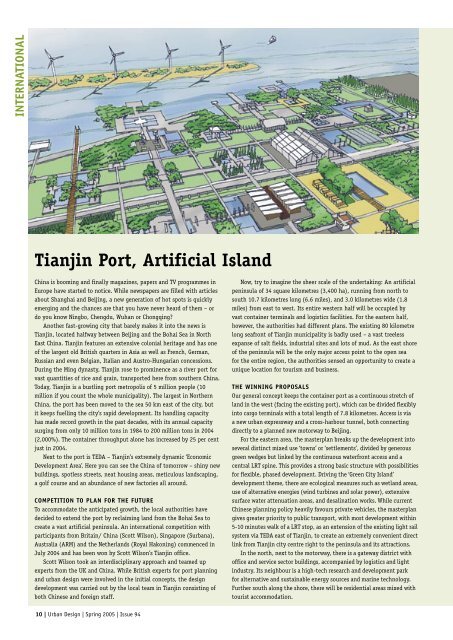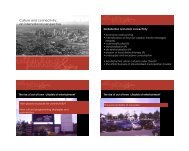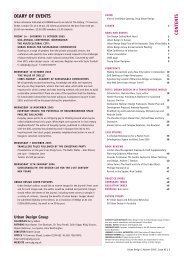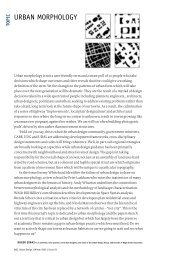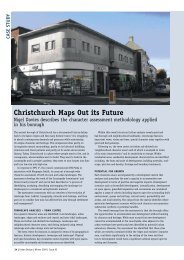CONTENTS DIARY OF EVENTS - The Urban Design Group
CONTENTS DIARY OF EVENTS - The Urban Design Group
CONTENTS DIARY OF EVENTS - The Urban Design Group
You also want an ePaper? Increase the reach of your titles
YUMPU automatically turns print PDFs into web optimized ePapers that Google loves.
INTERNATIONAL<br />
Tianjin Port, Artificial Island<br />
China is booming and finally magazines, papers and TV programmes in<br />
Europe have started to notice. While newspapers are filled with articles<br />
about Shanghai and Beijing, a new generation of hot spots is quickly<br />
emerging and the chances are that you have never heard of them – or<br />
do you know Ningbo, Chengdu, Wuhan or Chongqing?<br />
Another fast-growing city that barely makes it into the news is<br />
Tianjin, located halfway between Beijing and the Bohai Sea in North<br />
East China. Tianjin features an extensive colonial heritage and has one<br />
of the largest old British quarters in Asia as well as French, German,<br />
Russian and even Belgian, Italian and Austro-Hungarian concessions.<br />
During the Ming dynasty, Tianjin rose to prominence as a river port for<br />
vast quantities of rice and grain, transported here from southern China.<br />
Today, Tianjin is a bustling port metropolis of 5 million people (10<br />
million if you count the whole municipality). <strong>The</strong> largest in Northern<br />
China, the port has been moved to the sea 50 km east of the city, but<br />
it keeps fuelling the city’s rapid development. Its handling capacity<br />
has made record growth in the past decades, with its annual capacity<br />
surging from only 10 million tons in 1984 to 200 million tons in 2004<br />
(2,000%). <strong>The</strong> container throughput alone has increased by 25 per cent<br />
just in 2004.<br />
Next to the port is TEDA – Tianjin’s extremely dynamic ‘Economic<br />
Development Area’. Here you can see the China of tomorrow – shiny new<br />
buildings, spotless streets, neat housing areas, meticulous landscaping,<br />
a golf course and an abundance of new factories all around.<br />
COMPETITION TO PLAN FOR THE FUTURE<br />
To accommodate the anticipated growth, the local authorities have<br />
decided to extend the port by reclaiming land from the Bohai Sea to<br />
create a vast artificial peninsula. An international competition with<br />
participants from Britain/ China (Scott Wilson), Singapore (Surbana),<br />
Australia (ARM) and the Netherlands (Royal Hakoning) commenced in<br />
July 2004 and has been won by Scott Wilson’s Tianjin office.<br />
Scott Wilson took an interdisciplinary approach and teamed up<br />
experts from the UK and China. While British experts for port planning<br />
and urban design were involved in the initial concepts, the design<br />
development was carried out by the local team in Tianjin consisting of<br />
both Chinese and foreign staff.<br />
10 | <strong>Urban</strong> <strong>Design</strong> | Spring 2005 | Issue 94<br />
Now, try to imagine the sheer scale of the undertaking: An artificial<br />
peninsula of 34 square kilometres (3,400 ha), running from north to<br />
south 10.7 kilometres long (6.6 miles), and 3.0 kilometres wide (1.8<br />
miles) from east to west. Its entire western half will be occupied by<br />
vast container terminals and logistics facilities. For the eastern half,<br />
however, the authorities had different plans. <strong>The</strong> existing 80 kilometre<br />
long seafront of Tianjin municipality is badly used – a vast treeless<br />
expanse of salt fields, industrial sites and lots of mud. As the east shore<br />
of the peninsula will be the only major access point to the open sea<br />
for the entire region, the authorities sensed an opportunity to create a<br />
unique location for tourism and business.<br />
THE WINNING PROPOSALS<br />
Our general concept keeps the container port as a continuous stretch of<br />
land in the west (facing the existing port), which can be divided flexibly<br />
into cargo terminals with a total length of 7.8 kilometres. Access is via<br />
a new urban expressway and a cross-harbour tunnel, both connecting<br />
directly to a planned new motorway to Beijing.<br />
For the eastern area, the masterplan breaks up the development into<br />
several distinct mixed use ‘towns’ or ‘settlements’, divided by generous<br />
green wedges but linked by the continuous waterfront access and a<br />
central LRT spine. This provides a strong basic structure with possibilities<br />
for flexible, phased development. Driving the ‘Green City Island’<br />
development theme, there are ecological measures such as wetland areas,<br />
use of alternative energies (wind turbines and solar power), extensive<br />
surface water attenuation areas, and desalination works. While current<br />
Chinese planning policy heavily favours private vehicles, the masterplan<br />
gives greater priority to public transport, with most development within<br />
5-10 minutes walk of a LRT stop, as an extension of the existing light rail<br />
system via TEDA east of Tianjin, to create an extremely convenient direct<br />
link from Tianjin city centre right to the peninsula and its attractions.<br />
In the north, next to the motorway, there is a gateway district with<br />
office and service sector buildings, accompanied by logistics and light<br />
industry. Its neighbour is a high-tech research and development park<br />
for alternative and sustainable energy sources and marine technology.<br />
Further south along the shore, there will be residential areas mixed with<br />
tourist accommodation.


